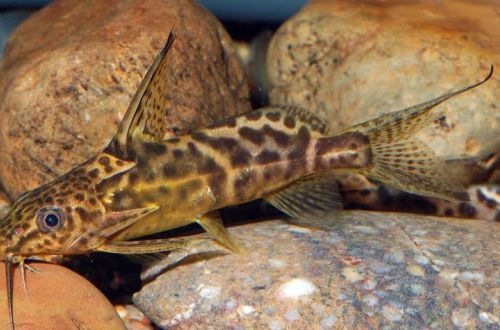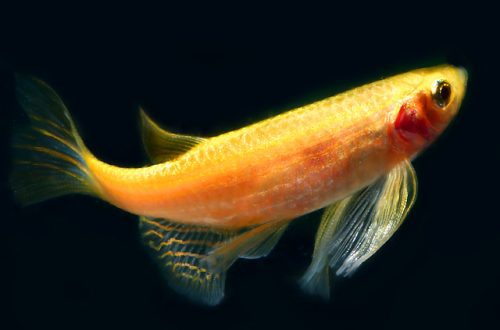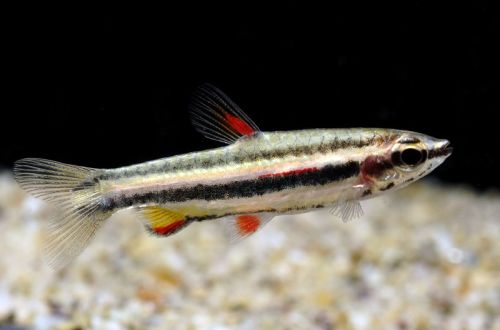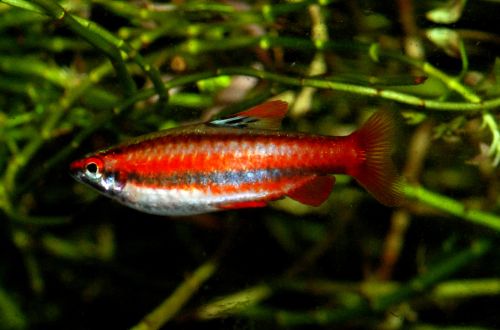
Синодонтис Конга
Greshoff’s Synodontis or Kongo’s Synodontis, scientific name Synodontis greshoffi, belongs to the Mochokidae family. Catfish has such a set of qualities as unpretentiousness, endurance and peaceful disposition, in addition, he has an original body pattern. All this makes it an excellent candidate for a community aquarium.

змест
Асяроддзе пражывання
It occurs in various biotopes of the Congo Basin. The range is limited to the territory of the modern Democratic Republic of the Congo, although this is a large part of the length of the river, so we can assume that the catfish is quite widespread in the wild. Like other members of the genus, it lives near the bottom, preferring to stick to areas with a slow current with a large number of shelters.
Кароткая інфармацыя:
- Аб'ём акварыума - ад 110 літраў.
- Тэмпература – 23-27°C
- Значэнне pH — 6.5–7.2
- Калянасць вады - ад мяккай да сярэдняй жорсткасці (3-15 dGH)
- Тып субстрата – пяшчаны, мяккі
- Асвятленне - прыглушанае або умеранае
- Саланаватай вады - не
- Рух вады - слабы або умераны
- Памер рыбы да 20 см.
- Харчаванне – любое ўтапленне
- Тэмперамент - мірны
- Трымаюцца паасобку або групай пры наяўнасці хованак
Апісанне
Adults reach a length of up to 20 cm, although in the natural environment they can grow much more. The body color is yellow-brown, cream-colored with an intricate pattern. The tail and fins have brown speckles on a translucent background, the first rays are significantly enlarged and are spikes for protection from potential predators. Sexual dimorphism is weakly expressed, it is quite problematic to distinguish a male from a female even for an experienced aquarist.
харчаванне
The diet of Synodontis Kongo includes almost all types of popular foods (dry, frozen and live) in combination with herbal supplements in the form of peeled peas, cucumber. The food must be sinking.
Змест і догляд, ўладкаванне акварыума
For one fish, a tank with a volume of 110 liters is enough. In the design, it is recommended to use a soft sandy substrate in which the catfish can freely dig without injuring itself. It is also necessary to provide shelters in the form of snags from the roots and branches of trees, or from other decorative items. Lighting is subdued, floating plants can act as a means of natural shading. In bright light, Synodontis is likely to spend most of its time in hiding. The rest of the design does not matter and is selected taking into account the needs of other fish.
In the process of maintaining the aquarium, pay special attention to the cleanliness of the soil, prevent silting and accumulation of organic waste, this not only worsens the quality of the water, but also increases the risk of infections. In addition to cleaning the substrate, a part of the water (15–20% of the volume) should be renewed weekly with fresh water to maintain biological balance.
Паводзіны і сумяшчальнасць
Greshoff’s Synodontis is considered a peaceful and accommodating species, but given its size and promiscuous diet, it can easily accidentally swallow a small fish. It is also worth avoiding the introduction of overly active or aggressive species that can harm the catfish and themselves suffer from its protective spikes.
Other representatives of the genus are not very friendly to their relatives and often come out in skirmishes for territory if they are in a small aquarium. However, this species is more tolerant and can be kept without problems not only singly, but also in a group. The main thing is that each catfish has its own shelter.
Развядзенне / развядзенне
In nature, Sinodontis Kongo produces offspring during the rainy season, scatters the eggs near the bottom, and does not show parental care. It is extremely difficult to initiate spawning in an aquarium. At the time of this publication, it was not possible to find reliable information about the breeding of this species at home. The fry are obtained from specialized commercial fish farms.
Хваробы рыб
Асноўнай прычынай большасці захворванняў з'яўляюцца непрыдатныя ўмовы жыцця і няякаснае харчаванне. Пры выяўленні першых сімптомаў варта праверыць параметры вады і наяўнасць высокіх канцэнтрацый небяспечных рэчываў (аміяку, нітрытаў, нітратаў і інш.), Пры неабходнасці прывесці паказчыкі ў норму і толькі пасля гэтага прыступаць да лячэння. Больш падрабязна аб сімптомах і лячэнні чытайце ў раздзеле Хваробы акварыўмных рыб.





